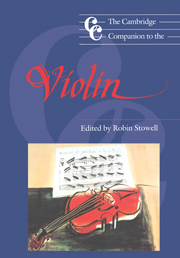Book contents
- Frontmatter
- 1 The violin and bow – origins and development
- 2 The physics of the violin
- 3 The violinists of the Baroque and Classical periods
- 4 The nineteenth-century bravura tradition
- 5 The twentieth century
- 6 The fundamentals of violin playing and teaching
- 7 Technique and performing practice
- 8 Aspects of contemporary technique (with comments about Cage, Feldman, Scelsi and Babbitt)
- 9 The concerto
- 10 The sonata
- 11 Other solo repertory
- 12 The violin as ensemble instrument
- 13 The pedagogical literature
- 14 The violin – instrument of four continents
- 15 The violin in jazz
- Appendix Principal violin treatises
- Glossary of technical terms
- Notes
- Select bibliography
- Index
1 - The violin and bow – origins and development
Published online by Cambridge University Press: 28 September 2011
- Frontmatter
- 1 The violin and bow – origins and development
- 2 The physics of the violin
- 3 The violinists of the Baroque and Classical periods
- 4 The nineteenth-century bravura tradition
- 5 The twentieth century
- 6 The fundamentals of violin playing and teaching
- 7 Technique and performing practice
- 8 Aspects of contemporary technique (with comments about Cage, Feldman, Scelsi and Babbitt)
- 9 The concerto
- 10 The sonata
- 11 Other solo repertory
- 12 The violin as ensemble instrument
- 13 The pedagogical literature
- 14 The violin – instrument of four continents
- 15 The violin in jazz
- Appendix Principal violin treatises
- Glossary of technical terms
- Notes
- Select bibliography
- Index
Summary
The violin: introduction and terminology
The violin is an endlessly fascinating instrument, both historically and artistically. A performer's instrument may be four hundred years old, but it will not differ significantly from one made yesterday. That the frail-looking violin has endured shows the perfection of its design, both as an expressive instrument of music and as a beautiful object in itself.
The violin is a mechanically simple but acoustically complex instrument. The four tapered tuning pegs for adjusting the G, D, A and E strings are made usually from rosewood or boxwood for durability, and project laterally from the backward curving pegbox (see Fig. 1). This latter ends in the scroll, a baroque adornment which is a characteristic feature of the violin family. The backward slope of the pegbox tensions the strings across the ebony nut, which is grooved to locate and raise them just above the surface of the ebony fingerboard, against which the strings are stopped by the fingers of the left hand. The fingerboard is glued to the neck, which is carved in one piece with the pegbox and scroll from maple (acer pseudoplatanus). It has a curved top in cross-section, and increases in width from the nut end to permit wider string spacing across the bridge, allowing easier movement for the bow.
- Type
- Chapter
- Information
- The Cambridge Companion to the Violin , pp. 1 - 29Publisher: Cambridge University PressPrint publication year: 1992
- 4
- Cited by



